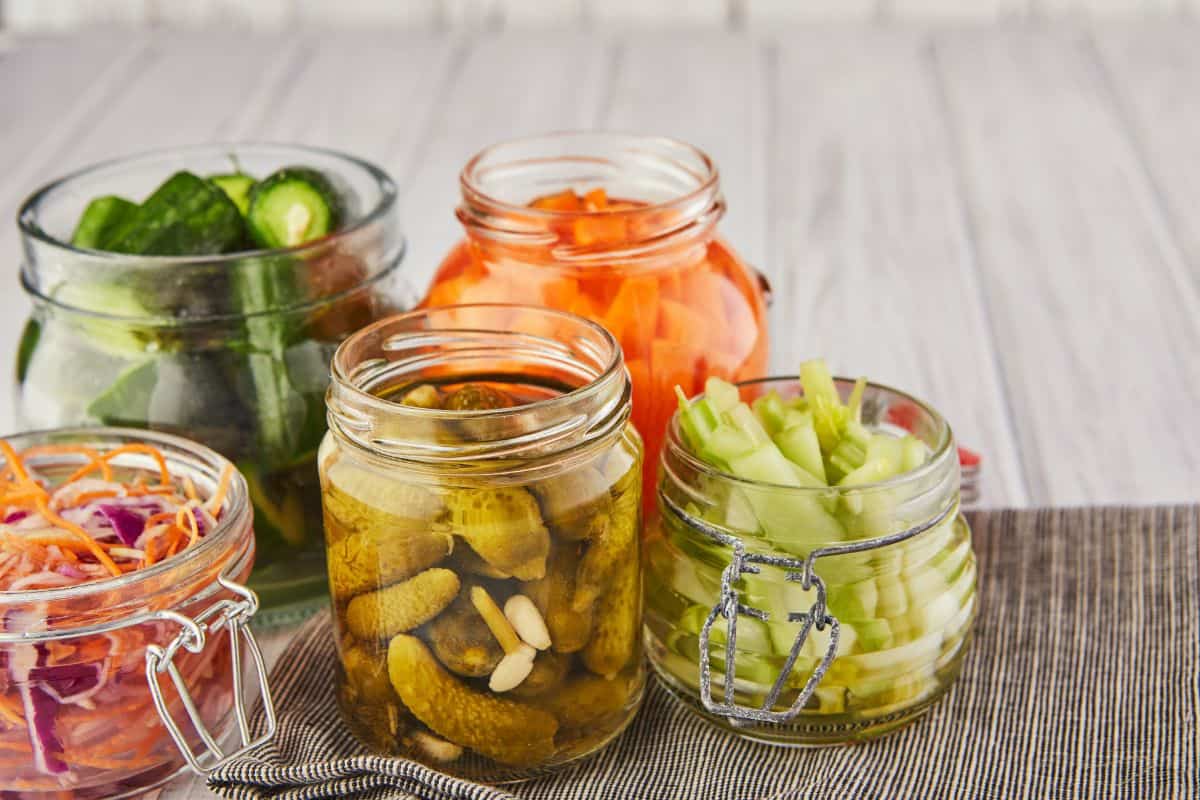Sauerkraut can be an underrated food despite its delicious sour and tangy flavor with crisp and crunchy texture! I myself love making sauerkraut and its versatility as a condiment, topping, or ingredient but I do know that it can be an acquired taste.
If you’re still on the fence about sauerkraut, have a closer look into this fermented food as well as possible substitutes to try!

Kimchi stands out as the top sauerkraut substitute, offering a slightly spicy, similar fermented cabbage taste. Alternatively, thinly sliced dill pickles are an accessible option, while using vinegar as a sauerkraut juice replacement or opting for a simple coleslaw can also serve as unfermented sauerkraut alternatives in recipes.
Jump To
What does sauerkraut taste like?
Sauerkraut has a distinctive taste that you can’t mistake. It’s sour and tangy but can vary in flavor due to factors such as the length of the fermentation process, the type of fermentation process used, and any additional ingredients added to the mixture, such as spices or seasonings.
The texture of sauerkraut can also vary based on the length of the fermentation process. Some sauerkraut is soft and tender, while others are crisp and slightly crunchy.
Want to Save This Recipe?
Enter your email and we’ll send the recipe directly to you!
By submitting this form, you consent to receive emails from The Yummy Bowl.
Best Sauerkraut Substitutes
If you’re looking for something similar in flavor and texture to sauerkraut, you may want to consider these substitutes:
Kimchi
Similar to sauerkraut, kimchi is a Korean fermented cabbage dish with a spicy kick due to its seasoning with chili peppers, garlic, and other spices.

Dill Pickles
Dill pickles share a similar fermented taste to sauerkraut due to same natural bacteria. They're commonly available in most grocery stores. Chop them into thin strips to mimic sauerkraut's appearance; though the texture differs, sliced dill pickles can replace sauerkraut in equal amounts. They make a perfect substitute, especially as a topping like on a hot dog, offering a winning flavor!

Pickled Cabbage
Pickled cabbage shares a tangy flavor profile with sauerkraut. It's made by pickling cabbage in vinegar, salt, and sometimes other spices.

Fermented Vegetables
Explore other fermented vegetables like pickles, pickled beets, or pickled onions. Though not exactly the same as sauerkraut, they can offer a tangy or sour element to dishes.

Coleslaw
While not fermented like sauerkraut, homemade coleslaw offers a crunchy texture and a mildly tangy flavor. It's made with shredded cabbage, carrots, and a creamy dressing.

Fresh Cabbage or Sauteed Cabbage With Vinegar
In some recipes, fresh cabbage can be used as a substitute. While it won't have the same fermented tang, it can still provide a similar texture and bulk to a dish.
To make it more similar to sauerkraut taste, add some apple cider vinegar or milder vinegar while sauteeing your cabbage. This will replace the ''sauerkraut juice'' perfectly.

How To Make Sauerkraut?
Making your own sauerkraut is relatively easy and straightforward. You only need to have 2 ingredients: cabbage, salt!
- Recipe: How To Make Homemade Sauerkraut
How To Use Sauerkraut?
Sauerkraut can be enjoyed as:
- A condiment on hot dogs, burgers, and sandwiches (like the popular Reuben sandwich);
- An ingredient in soups, stews, stir-fries, and salads; or
- A side dish to grilled meats and pork sausages.
- The sauerkraut juice can also be used to make salad dressings and marinades!

FAQs
Sauerkraut consists of shredded cabbage that undergoes a fermentation process, turning the natural sugars from the cabbage into lactic acid bacteria. As a result, the sauerkraut has a sour taste.
Sauerkraut is a German term where it is believed to have originated, although it also has origins throughout Central Europe. “Sauer” in German means sour, and “kraut” means cabbage.
Sauerkraut is a nutritious food offering rich source of vitamins and minerals, as well as dietary fiber. The fermentation process results in the growth of probiotics which aids digestion.
Sauerkraut can be eaten raw, or it can be cooked.
It’s best to avoid sauerkraut when pregnant, have allergies or other food allergies, suffer from blood pressure issues, or have an immune deficiency.
You Might Also Like
I would appreciate it so much if you left a comment about this post below! Subscribe to join the TYB newsletter and receive free recipes straight to your inbox! Let's connect via Facebook, IG & Pinterest!







Julia | The Yummy Bowl
Easy altermatives to sauerkraut.